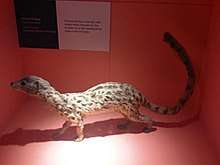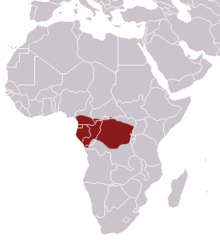Central African oyan
The Central African oyan (Poiana richardsonii), also called Central African linsang, is a linsang species native to Central Africa.[1]
| Central African oyan | |
|---|---|
 | |
| Scientific classification | |
| Kingdom: | Animalia |
| Phylum: | Chordata |
| Class: | Mammalia |
| Order: | Carnivora |
| Suborder: | Feliformia |
| Family: | Viverridae |
| Genus: | Poiana |
| Species: | P. richardsonii[2] |
| Binomial name | |
| Poiana richardsonii[2] Thomson, 1842 | |
 | |
| Central African oyan range | |
Characteristics
The Central African oyan's body is slender and long, with an elongated head and a pointed muzzle. Its fur is yellowish to reddish brown with darker spots on the back and flanks. Its throat and belly are lighter in colour and without spots. Its tail has 9 to 14 dark rings. Its body is 33–43 cm (13–17 in) long, and the tail about the same length. Its legs are short, and the soles of its feet hairy. Females are slightly smaller than males.[3]
Distribution and habitat
The Central African oyan is endemic to Cameroon, Equatorial Guinea, Gabon, the Central African Republic, the Republic of the Congo, and the Democratic Republic of the Congo east to the Albertine Rift. It lives in lowland and montane tropical rainforests.[1] In Gabon, a camera-trap recorded an individual on the forest floor.[4] In Gabon's Moukalaba-Doudou National Park, it was also recorded only in forested areas.[5]
Behaviour and ecology
The Central African oyan lives foremost in the canopy, but has rarely been observed on the ground. It is nocturnal and hunts small rodents and birds, but also feeds on insects.[3]
Taxonomy
The Central African oyan was first described in 1842 as Genetta richardsonii by T. R. H. Thomson based on a zoological specimen collected in Fernando Po.[7] In 1864, John Edward Gray subordinated it to the genus Poiana.[8]
Threats
The Central African oyan is possibly threatened by deforestation and bushmeat hunting.[1]
References
- Gaubert, P. & Do Linh San, E. (2015). "Poiana richardsonii". IUCN Red List of Threatened Species. 2015: e.T41704A45219609. Retrieved 30 October 2018.
- Wozencraft, W.C. (2005). "Species Poiana richardsonii". In Wilson, D.E.; Reeder, D.M (eds.). Mammal Species of the World: A Taxonomic and Geographic Reference (3rd ed.). Johns Hopkins University Press. pp. 532–628. ISBN 978-0-8018-8221-0. OCLC 62265494.
- Van Rompaey, H. and Colyn, M. (2013). "Poiana richardsonii Central African Linsang (Central African Oyan)". In Kingdon, J.; Hoffmann, M. (eds.). The Mammals of Africa. V. Carnivores, Pangolins, Equids and Rhinoceroses. London: Bloomsbury. pp. 253−254.CS1 maint: multiple names: authors list (link)
- Bahaa-el-din, L., Henschel, P., Aba’a, R., Abernethy, K., Bohm, T., Bout, N., Coad, L., Head, J., Inoue, E., Lahm, S., Lee, M. E., Maisels, F., Rabanal, L., Starkey, M., Taylor, G., Vanthomme, A., Nakashima, Y. and Hunter, L. (2013). "Notes on the distribution and status of small carnivores in Gabon". Small Carnivore Conservation. 48: 19–29.CS1 maint: uses authors parameter (link)
- Nakashima, Y. (2015). "Inventorying medium-and large-sized mammals in the African lowland rainforest using camera trapping". Tropics. 23 (4): 151–164. doi:10.3759/tropics.23.151.
- Whitfield, P., ed. (1984). Macmillan Illustrated Animal Encyclopedia. Macmillan Publishing Company. p. 92. ISBN 0-02-627680-1.
- Thomson, T. R. H. (1842). "Description of a new species of Genetta, and of two species of Birds from Western Africa". The Annals and Magazine of Natural History; Zoology, Botany, and Geology. 10 (64): 203–205. doi:10.1080/03745484209445224.
- Gray, J. E. (1864). "A Revision of the Genera and Species of Viverrine Animals (Viverridae) founded on the collection in the British Museum". Proceedings of the Zoological Society of London: 502–579.
